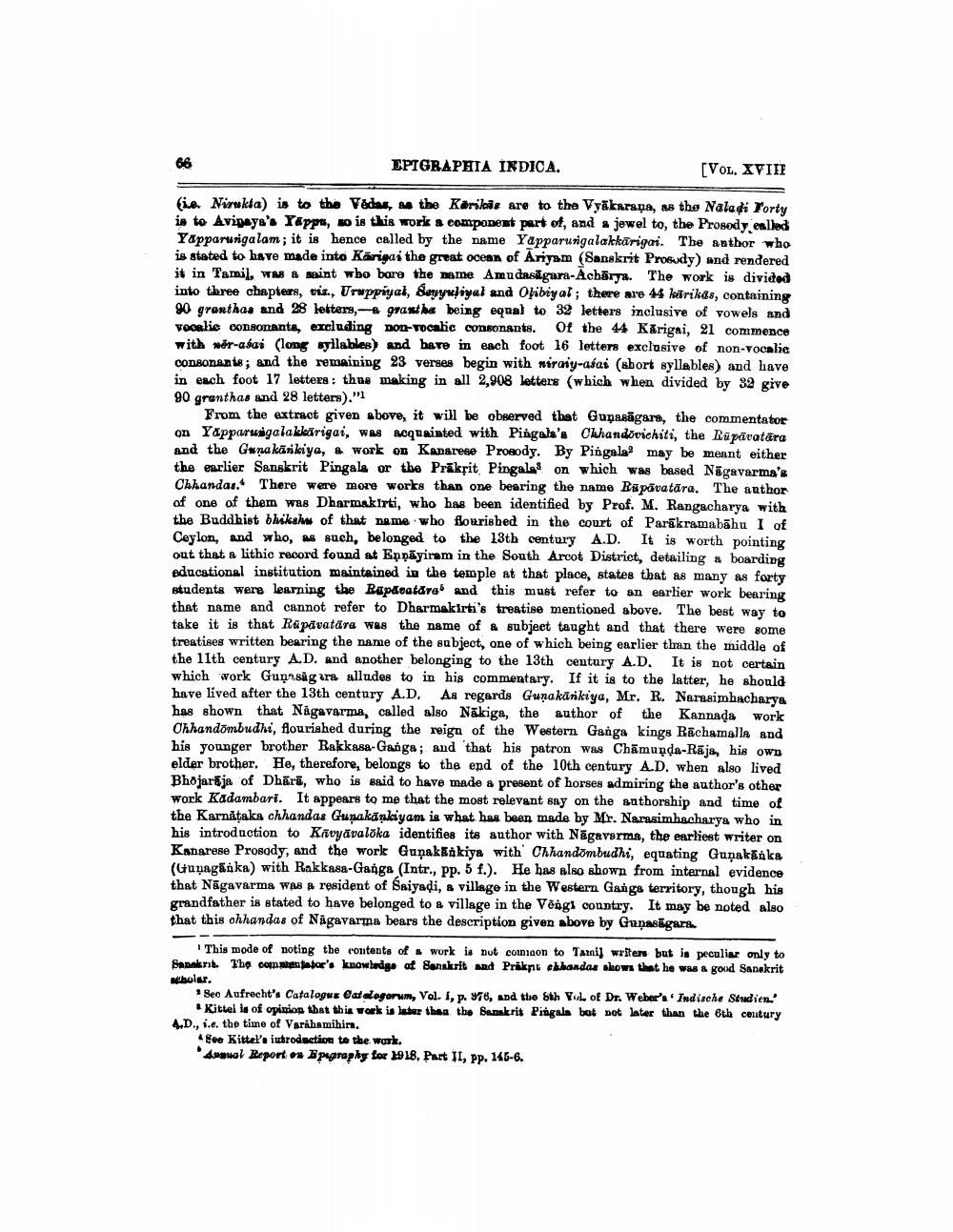________________
EPIGRAPHIA INDICA.
[VOL. XVIIE
(ie Nirukia) is to the Vedas, m the Kärilas are to the Vyakarana, as the Naladi Torty is to Avipaya's Yappa, wo is this work a component part of, and jewel to, the Prosody called Yapparurigalam; it is hence called by the name Yapparurigalakkārigai. The author who is stated to have made into Kärigai the great ocean of Ariyam (Sanskrit Prosudy) and rendered it in Tamil, W & saint who bare the name Amudasłgara-Achārya. The work is divided into three chapters, vie., Uruppiyal, Seyyuliyal and Obibiyal; there are 44 kīrikas, containing 90 groxthas and 28 letters, - grantha being equal to 32 letters inclusive of vowels and vocalie consonante, excluding non-vocatic consonants. Of the 44 KĀrigai, 21 commence with wör-asai (long syllables) and have in each foot 16 letters exclusive of non-vocalia consonants; and the remaining 23 verses begin with niraiy-asas (short syllables) and have in each foot 17 letters: thus making in all 2,908 letters (which when divided by 32 give 90 granthas and 28 letters)."
From the extract given above, it will be observed that Guņasāgars, the commentator on Yapparusigalakkedrigai, was acquainted with Pingala's Olhandovichiti, the Rūpāvatūra and the Guna käsikiya, & work on Kanarese Prosody. By Pingala? may be meant either the earlier Sanskrit Pingala or the Prākpit Pingalad on which was based Nāgavarma's Chhandas. There were more works than one bearing the name Rapavatara. The author of one of them was Dharmakirti, who has been identified by Prof. M. Rangacharya with the Buddhist blikah of that name who flourished in the court of Parakramabāhu I of Ceylon, and who, as such, belonged to the 13th century A.D. It is worth pointing out that a lithic record found at Epnāyiram in the South Arcot District, detailing a boarding educational institution maintained in the temple at that place, states that as many as forty students were learning the Raptoatdrab and this must refer to an earlier work bearing that name and cannot refer to Dharmakirti's treatise mentioned above. The best way to take it is that Rapavatāra was the name of a subject taught and that there were some treatises written bearing the name of the subject, one of which being earlier than the middle of the 11th century A.D. and another belonging to the 13th century A.D. It is not certain which work Gunnsåg ara alludes to in his commentary. If it is to the latter, he should have lived after the 13th century A.D. As regards Gunakarikiya, Mr. R. Narasimhacharya has shown that Någavarma, called also Nākiga, the author of the Kannada work Ohhandombudhi, flourished during the reign of the Western Ganga kings Richamalla and his younger brother Rakkasa-Ganga; and that his patron was Chamunda-Rājs, his own elder brother. He, therefore, belongs to the end of the 10th century A.D. when also lived Bhojarēja of Dhārā, who is said to have made a present of horses admiring the author's other work Kadambari. It appears to me that the most relevant say on the authorship and time of the Karnătaka chhandas Gunakankiyam is what has been made by Mr. Narasimhacharya who in his introduction to Kavyāvaloka identifies its author with Nāgaverma, the earliest writer on Kanarese Prosody, and the work Gunak ikiya with Ohhandombudhi, equating Gunakan ka (Gunagkaka) with Rakkasa-Ganga (Intr., pp. 5 f.). He has also shown from internal evidence that Nāgavarma Was A resident of Saiyadi, & village in the Western Ganga territory, though his grandfather is stated to have belonged to a village in the Véngt country. It may be noted also that this chhandas of Nagavarma bears the description given above by Gunasāgars.
This mode of noting the contents of work is not consaon to Tamil writers but is peculiar only to Bapakid. The commentator's knowledge of Sanskrit and Print blandas shown that he was a good Sanskrit bolar.
* Sec Aufrecht's Catalogue Oat dogorum, Vol. I, p. 976, and the 6th Yol of Dr. Weber's Indische Studien.'
• Kittel is of opinion that this work is later than the Sanskrit Pingala bob not later than the oth century 4.D., i.e. the time of Varkhamihin.
Eve Kittel' iubroduction to the work. usual Report on Bpography for 1918, Part II, pp. 146-6.




